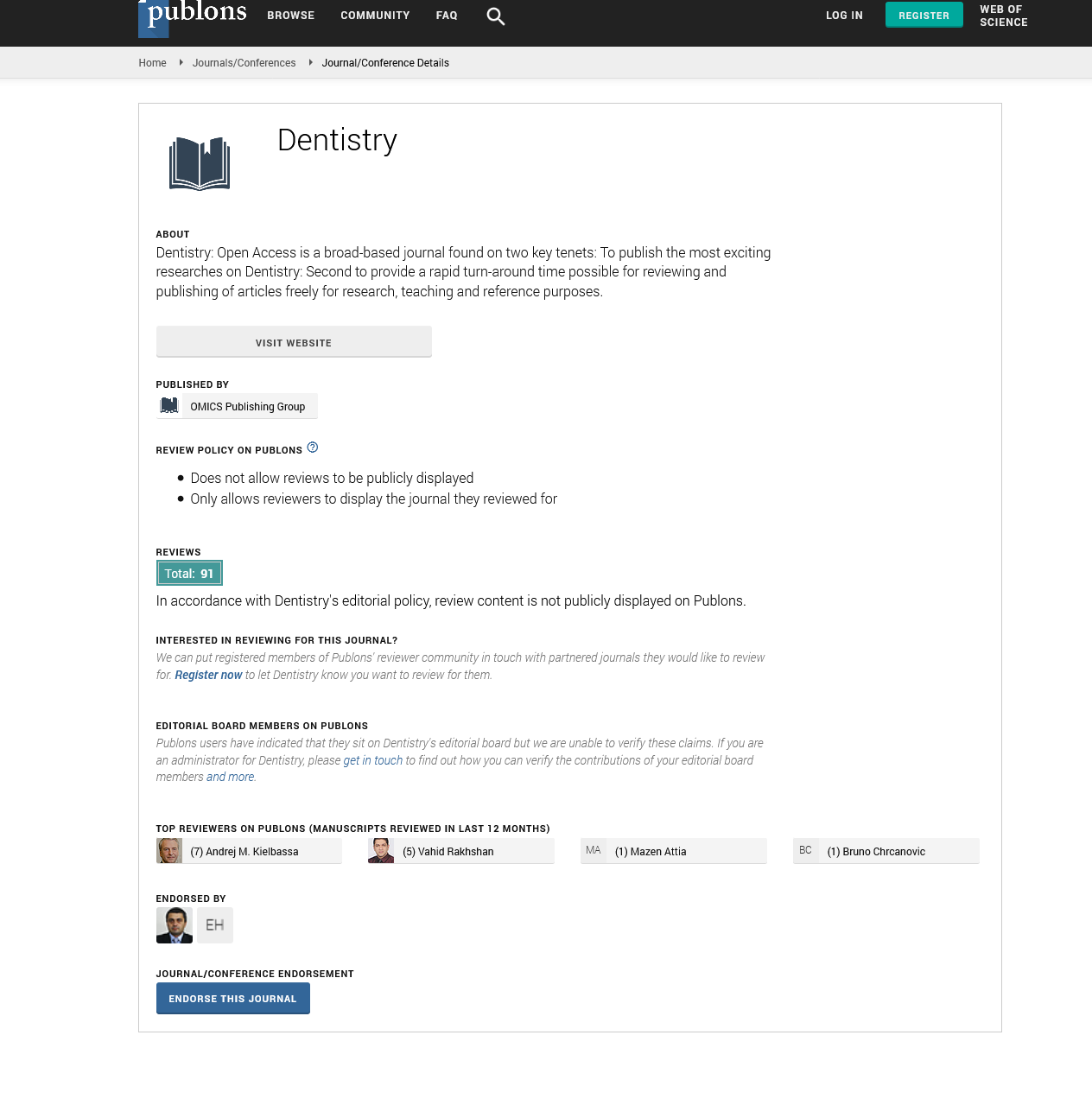Citations : 2345
Dentistry received 2345 citations as per Google Scholar report
Indexed In
- Genamics JournalSeek
- JournalTOCs
- CiteFactor
- Ulrich's Periodicals Directory
- RefSeek
- Hamdard University
- EBSCO A-Z
- Directory of Abstract Indexing for Journals
- OCLC- WorldCat
- Publons
- Geneva Foundation for Medical Education and Research
- Euro Pub
- Google Scholar
Useful Links
Share This Page
Journal Flyer

Open Access Journals
- Agri and Aquaculture
- Biochemistry
- Bioinformatics & Systems Biology
- Business & Management
- Chemistry
- Clinical Sciences
- Engineering
- Food & Nutrition
- General Science
- Genetics & Molecular Biology
- Immunology & Microbiology
- Medical Sciences
- Neuroscience & Psychology
- Nursing & Health Care
- Pharmaceutical Sciences
Perspective - (2023) Volume 13, Issue 1
Patients with Clinical Manifestations Oral Symptoms and Dental Conditions
Annette Karen*Received: 02-Jan-2023, Manuscript No. DCR-23-19872; Editor assigned: 05-Jan-2023, Pre QC No. DCR-23-19872(PQ); Reviewed: 19-Jan-2023, QC No. DCR-23-19872; Revised: 26-Jan-2023, Manuscript No. DCR-23-19872(R); Published: 03-Feb-2023, DOI: 10.35248/2161-1122.23.13.617
About the Study
Dentists may treat patients who have inexplicable problems that don't get better with standard dental care. These complaints include occlusal pain and chronic pain or discomfort in the mouth cavity, such as a feeling of a foreign body. However, these are rare, and the patients often do not receive adequate treatment. Complaints of pain that won't go away or bite that doesn't fit have been conventionally referred to as oral psychosomatic disorders.
Internal medicine does not always define these problems as psychosomatic ailments. According to reports, 50% of individuals with oral psychosomatic disorders also have associated psychosomatic illnesses as anxiety and depression. Therefore, it could be challenging for General Practitioner (GP) dentists to differentiate among psychiatric illnesses and dental psychosomatic disorders. Patients who would have been hospitalised in the past are now receiving medical care while living in society as a result of a decrease of mental beds in recent years. These people also go to dental offices with dental concerns, and it is becoming more typical for situations to arise that do not have simple solutions. Whether or not a concurrent mental illness exists, such people are perceived by GPs as patients who cannot be treated effectively. Dentists may not notice a patient's mental status until they report a decline in their condition. It is crucial to swiftly identify latent mental problems in patients who visit dental clinics for the proper dental care; yet, no method has yet been created.
Patients that have no organic abnormalities but oral psychological illnesses may still have good oral health. A gum disease microenvironment is reportedly seen in persons with psychosomatic problems. Patients with severe mental illnesses are more likely than the general population to lose all of their teeth and to have an oral environment that is substantially worse than usual was said before, even in terms of the patients' oral environment, oral psychosomatic disorders may not be the same as psychiatric conditions. The oral environment of the two groups has not, however, been the subject of research that has been reported. Extensively used as a measure of the prevalence of caries in a community or group. It contains the overall number of Filled Teeth, Missing Teeth, and Decaying Teeth (FT, MT and DT). This index has a range of 0 to 28, with higher values suggesting that the patient has experienced more caries and has worse oral health. We concentrated on the DMFT index in this study since it is simple to apply during normal oral exams. The purpose of this study was to better understand the features of patients with oral psychosomatic disorder's oral environment.
Oral psychosomatic disorder patients. The DMFT index score was significantly different among the patient groups (P<0.001). Particularly, individuals with oral psychosomatic diseases had considerably lower DMFT scores than those with psychiatric inpatients. Patients with oral psychosomatic problems were substantially more numerous than those with general dentistry (P 0.001). Patients with oral psychosomatic disorders had the highest FT scores, which showed a significant difference between the three groups' FT scores. Between the three groups, there were no discernible differences in the DT score. The DMFT and DT scores of mental inpatients were substantially higher than those of oral psychosomatic and general dental patients (P 0.001) in the 45-64 year age range.
Psychiatric inpatients had much lower FT scores and significantly higher MT scores than the other two groups. Between patient groups, there was no discernible variation in the DT score. With substantial variations between the three, the DMFT score for patients over 65 years old was highest for the mental inpatient group, followed by the oral psychosomatic group, and lowest for the regular dental patient group. (P<0.001). There were no discernible variations between the three patient groups' DMFT, DT, MT, or FT scores in the 18-44 age range.
Citation: Karen A (2023) Patients with Clinical Manifestations Oral Symptoms and Dental Conditions. J Dentistry. 13:617.
Copyright: © 2023 Karen A. This is an open access article distributed under the terms of the Creative Commons Attribution License, which permits unrestricted use, distribution, and reproduction in any medium, provided the original author and source are credited.

